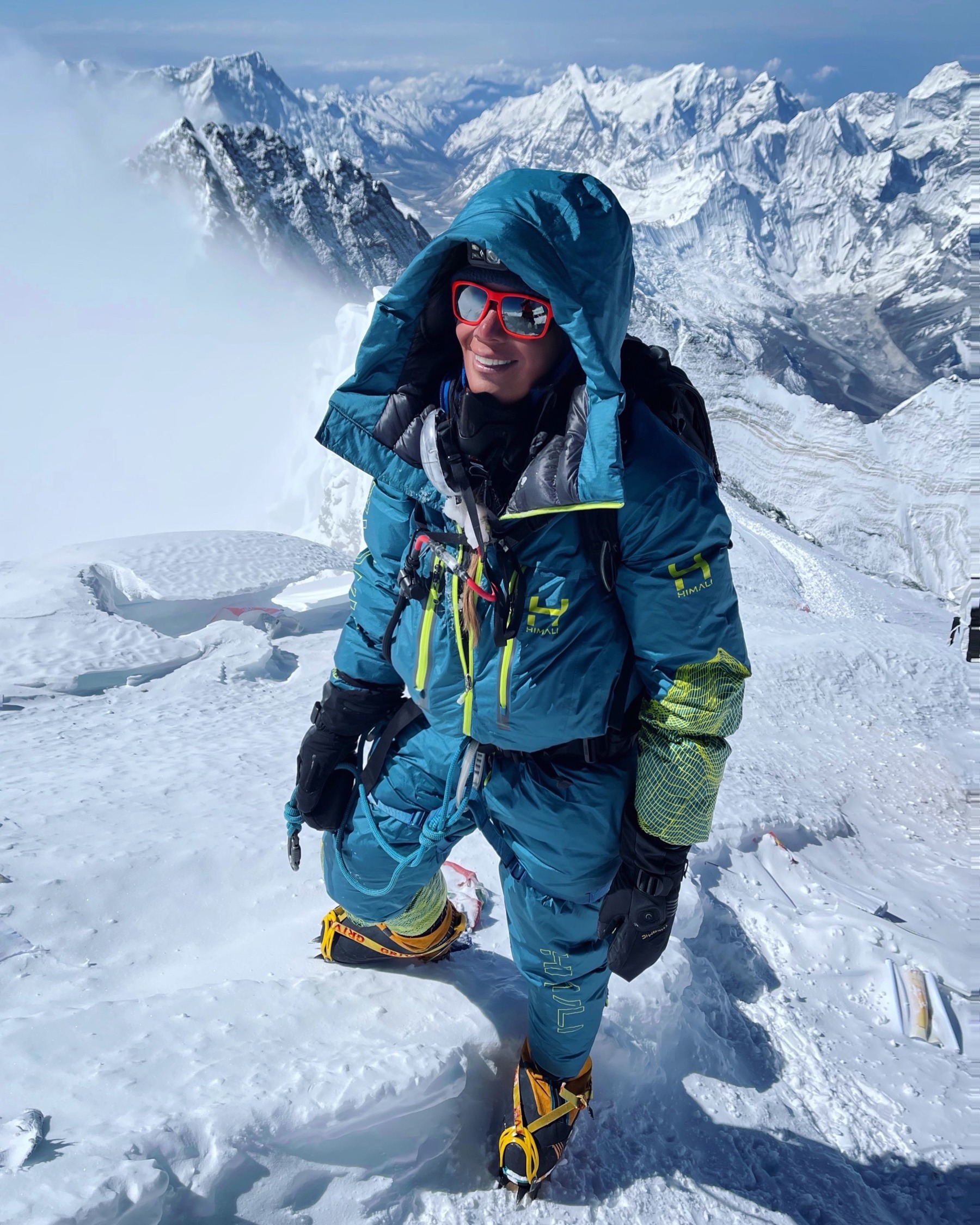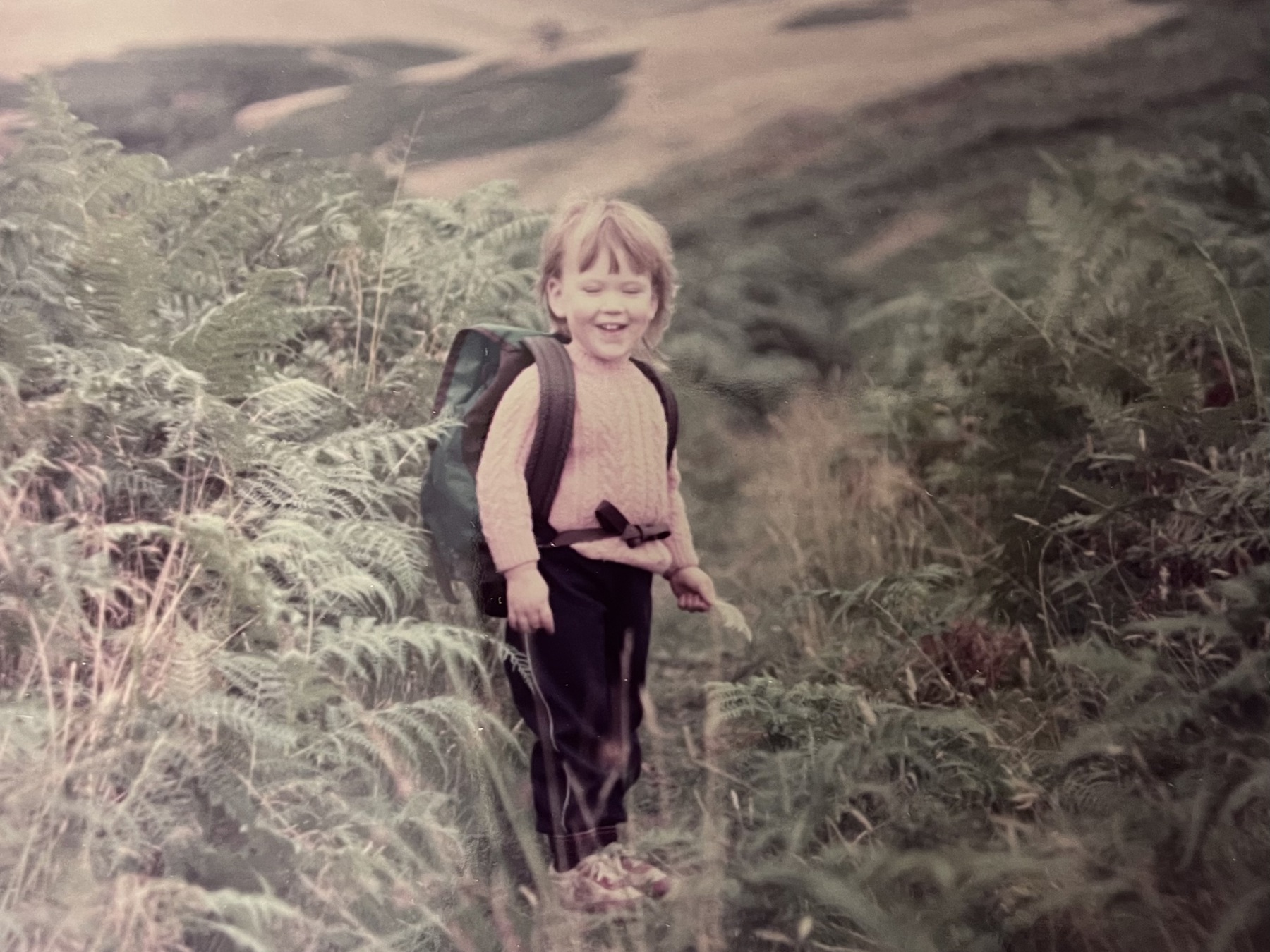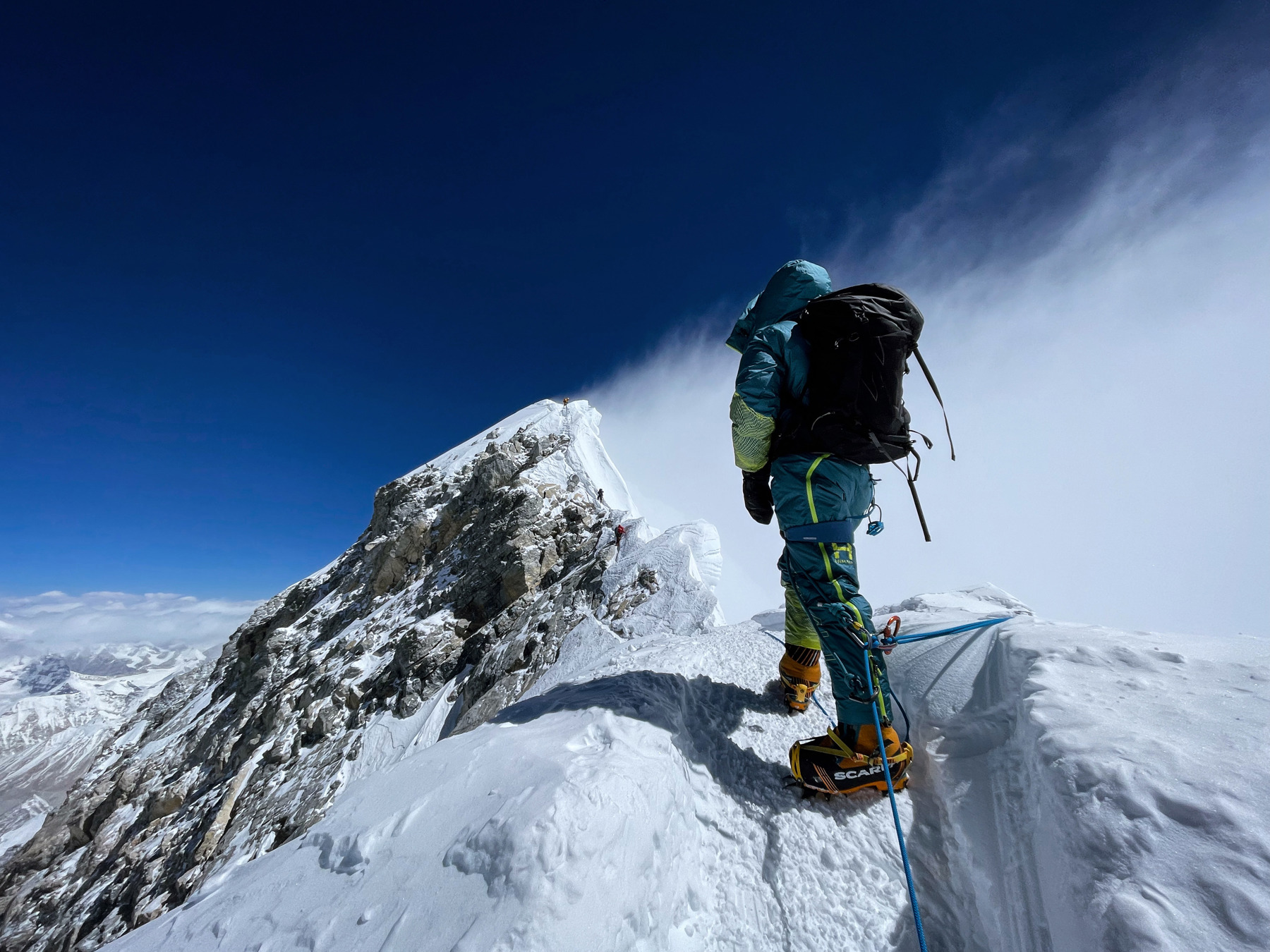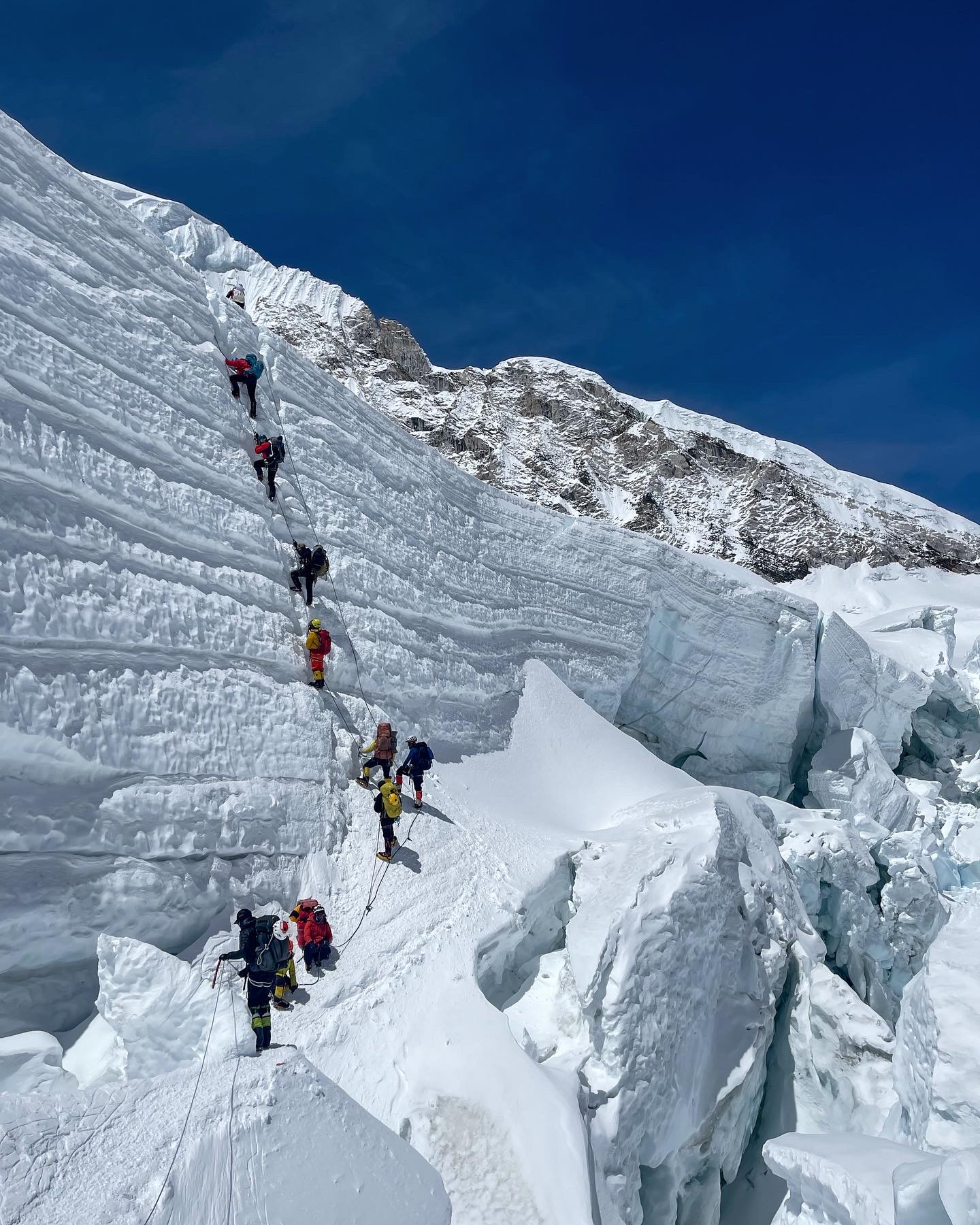Stirling effort: The Scout on the summit of Everest
Kirsty Mack, from Bridge of Allan, Scotland, went to her first Scout camp when she was just three months old. On May 22 this year, at 8:10am, she became the sixth woman from Scotland to reach the summit of Mount Everest, despite having only partial use of one of her arms. She follows in the footsteps of her father, a legendary outdoorsman and Scout volunteer for over seventy years.
My dad Tom, a keen mountaineer himself, introduced my sister and me to the outdoors when we were very young. He was Group Scout Leader of our local Menstrie Scout Group, so we attended most Scout activities as a family. My first camping adventure – a Chief Scout’s visit weekend – happened when I was just three months old.
Dad was incredibly passionate about Scouts and encouraging young people to learn new skills. He was awarded the highest accolade in Scouts, the Silver Wolf, in 1990, followed by an MBE for services to Scouts in 1997. In 2020 he was recognised for 70 years of continuous service, receiving the 70 years’ service award.
My sister Lynzie is now Group Scout Leader for the same group, and I’ve been the group treasurer for around 15 years.

Early days in Scouts
I first joined Scouts as a Cub aged eight, which was a great introduction to the movement, before I joined the Scout section a few years later.
In Scouts, I progressed through the awards scheme from the Scout Award – which provided a basic level of navigation, rope skills, first aid, camping, and survival skills – to the final, highest award, the Chief Scout's Award. Each stage of the award scheme pathway at that time (Scout Award, Pathfinder Award, Explorer Award, and Chief Scout’s Award) provided valuable skills that I continually built upon as I progressed.
At 15, I became a Patrol Leader, which taught me valuable skills in leadership and teamwork. Each year, our group held two main camps – Easter (three days) and Summer (seven days) – during which we used the skills we learned throughout the year. We still look back on these camps today.
A good friend and I were reminiscing recently about our Chief Scout’s Challenge on the Isle of Arran. Even though I’ve now climbed Mount Everest, our Chief Scout’s Challenge remains the hardest thing I’ve ever done! We were about 14 at the time, and it was the first time we’d carried everything required for a multi-day expedition by ourselves: our tents, spare clothes, and food for the whole expedition.
We covered several miles each day, and the terrain was quite challenging at times. We lost our way a few times and we dropped one of our tents in a stream. The weather was awful – typically Scottish – and the midges ate us alive. Looking back on it now, though, it was probably one of the best adventures we’ve ever had.

Summiting Kilimanjaro
My very first ‘high altitude’ mountain was Mount Kilimanjaro in Africa. I lived in Tanzania at the time doing voluntary work and unexpectedly had four days off. I wondered if climbing Kilimanjaro in four days would be possible, but I was told it would take a minimum of six. I went anyway and managed to summit in three days. I really enjoyed the climb and was incredibly lucky to have no ill effects from the altitude. From that point on, I was hooked.
My next high-altitude peak was Mount Elbrus in Russia (the highest mountain in Europe), which my dad had climbed 25 years before as part of a Scout team celebrating 100 years of Scouts.
I also climbed Denali in Alaska (the highest peak in North America) shortly after my dad passed away. He climbed it in 1981 with a fellow Scout and always spoke so fondly of his time there. Following in his footsteps 41 years later felt like a nice way to honour his memory. I took his photograph album from 1981 with me to Alaska and retook several of his pictures. Knowing I stood in almost the exact same spots all those years later filled me with a surge of conflicting emotions, with happiness dominating them all.
After Denali, I was encouraged to try an 8000m peak, so eventually I headed to Manaslu (the eighth highest mountain in the world) in Nepal. From Manaslu, I went first to Ama Dablam and then to Aconcagua (the highest mountain in South America) before heading to Mount Everest.
In between climbing these big mountains, I spend lots of time in the hills of Scotland. I tend to split my time between Scotland and the Alps, where I climb and ski (I’m a ski instructor).
Overcoming setbacks
Unfortunately my adventures in the mountains haven't been without some serious setbacks. Two years ago, while skiing off-piste in the Cairngorms, I had an unfortunate accident and was airlifted to hospital with a badly injured shoulder and arm. I had several surgeries and much rehab, but unfortunately, I never regained full use of my dominant left arm. Currently, I have around 65% movement in that arm.
Denali was one of my first big expeditions to follow my injury, and while the experience was fantastic, it provided real insight into the problems I now face in the mountains due to my reduced mobility. Back in Scotland, I worked on these new weaknesses with my trainer, Bradley, concentrating on mountain-specific strength and movement.
I went to Everest knowing my injury might hold me back. I was as physically prepared as I could be and well acclimatised, and I had the mental determination to push through, but the unknown conditions of what lay ahead and whether my shoulder and arm could manage certain technical sections concerned me.
On our summit push, we carried weight for close to 22 hours straight, which became incredibly painful towards the end of the day, but it’s amazing how much you can cope with when you’re focused and determined.

Why Everest?
When I was a child, my dad would go to mountain film festivals, and one day he came back with a signed picture of Dougal Haston, the great Scottish climber, on the Hillary Step (one of the last obstacles to the summit).
That picture remained on my bedroom wall for most of my childhood. Growing up, I really admired British climbers like Dougal Haston, Doug Scott, Stephen Venables, and Chris Bonington, but I never dreamed that someone like me would ever even see Everest with my own eyes, let alone climb it.
When the opportunity to join an Everest expedition arose, and I learned that several friends I’d previously climbed with would be on the same team, I couldn’t really say no. I also realised that I had inadvertently already climbed four of the seven summits (the highest peak on each of the seven continents) and Everest would be my fifth.
Everest is probably the only mountain I’ve gone to climb where I’ve had a preconceived idea of what it would be like. There are so many books, movies, and articles on Everest that not forming an opinion is difficult. However, it was nothing like I thought it would be, which surprised me.
Some sections are certainly scary, and you have to be very focused, but it’s also incredibly beautiful with an enormous variety of terrain, and it's actually a really fun mountain. My summit day was very quiet; only two other people were on the Hillary step and just a handful of climbers stood on the summit – the mountain did not feel overcrowded or busy at all.
Scary moments
The Khumbu Icefall is one of the most, if not the most, dangerous sections of the South Col route and begins just above base camp. The icefall is a section of the Khumbu Glacier – essentially 5km of constantly moving ice. The icefall itself is 1.62 miles (2.3km) long. It’s full of crevasses and overhanging ice and can move up to 1m each day.
I found it utterly terrifying and completely mesmerising in equal measure. The section feels like another planet. Blocks of ice look the size of buildings. You move through the Khumbu at night when it’s dark, before the sun comes up and the ice begins to melt. There are various ladders and technical bits to navigate. With my shoulder issues and reduced mobility, this section made me the most anxious.
We had two quite scary moments during our summit push, both in the Khumbu Icefall. The first was when my climbing partner, Lhakpa, went to jump across a small crevasse. It was very dark, so we had only our head torches to see with. Just as his feet left the ground, the whole area around the small crevasse collapsed, and suddenly a huge void loomed between us. I spent a while trying alternative ways across, but every snow bridge would just collapse beneath my feet. Eventually, I had to take a running jump and hope for the best. Luckily, it worked out okay.
The second was an avalanche that started above us, caused by a falling serac. Unfortunately, I’ve been involved in a few avalanches in Nepal now, and they never get any less terrifying. Each avalanche happens very quickly, and there is very little you can do. Fortunately, this one covered us only slightly, and everyone was alright.

Scout skills
Looking back, being a Scout gave me a huge skill set that I’ve continued to use in my adult life. I feel very lucky to know how to climb, ski, kayak, and look after myself on the hill. Having knowledge of navigation, camping, and general survival skills has served me well, and I definitely used these during my time on Everest.
There’s a confidence and comfort that come with having these skills in your back pocket, so to speak. I would highly recommend Scouts to every child – you’ll learn lots of lifelong skills, make lifelong friends, and have an amazing time in the process.
What would my advice be to young people taking their first step into the world of adventure? Try to find some like-minded people and just get involved. There are so many amazing activities that can enable adventure – and Scouts will give you a great taste of many of these.
Don’t be afraid if you don’t get everything right the first time; you’ll learn so much more from not always succeeding. I’ve learned far more from the setbacks I’ve encountered (and there have been a lot) than any successes I’ve had. Encourage your friends to try something new with you and learn to work as part of a team. Look after each other, and most importantly, have fun!
Looking ahead
I’ve got two of the seven summits left to complete: Mount Vinson in Antarctica and Carstensz Pyramid in Indonesia. I’d love to go to Mt. Vinson next, but it’s very expensive, and New Guinea isn’t possible now for political reasons. I’m hopeful that I’ll have the opportunity to do these in the next few years, though.
My dad climbed many of these mountains, and I’m proud to follow in his footsteps. After he died, my family received so many incredibly touching cards and letters from former Scouts who said he’d inspired them and that they still remembered the things they learned as Scouts. He brightened so many lives, especially mine.